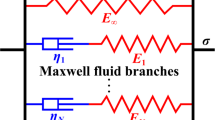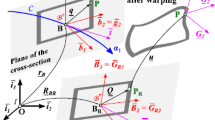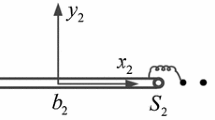Abstract
In this work we present a multibody dynamics system composed of geometrically exact nonlinear beams with inelastic behavior, representing flexible system components. The main focus of the work is to introduce advanced energy dissipation models using hardening and softening plasticity into such beam models and to show how they can also recover a vibration amplitude decay typical of viscous damping. The damping model is represented by the constitutive behavior of the flexible beam element chosen as an elasto-viscoplastic response with linear isotropic hardening and subsequent softening plasticity. The formulation is cast within the mixed variational framework, where the strong embedded discontinuity is introduced into displacement/rotation fields in the softening phase leading to localized plastic deformation. We also aim to ensure model capabilities to deliver results for long-term loading simulations, which is of interest for quantifying the risk of fatigue failure for such flexible system component. The corresponding numerical implementation combines the space discretization based on the finite element method with the time discretization based upon energy-conserving or energy-decaying integration schemes. The results of several numerical simulations are presented in the dynamics of flexible-rigid multi-body systems to illustrate a very satisfying performance of the proposed model.
















Similar content being viewed by others
References
Arnold, M.: Constraint partitioning in dynamic iteration methods. Z. Angew. Math. Mech. 81, 735–738 (2001)
Bauchau, O.A., Nemani, N.: Modeling viscoelastic behavior in flexible multibody systems. Multibody Syst. Dyn. 51(2), 159–194 (2020)
Bauchau, O.A., Damilano, G., Theron, N.J.: Numerical integration of nonlinear elastic multi-body systems. Int. J. Numer. Methods Eng. 38, 2737–2751 (1995)
Betsch, P., Uhlar, S.: Energy-momentum conserving integration of multibody dynamics. Multibody Syst. Dyn. 17, 243–289 (2007)
Brüls, O., Cardona, A.: On the use of Lie group time integrators in multibody dynamics. J. Comput. Nonlinear Dyn. 5(3), 031002 (2010)
Cardona, A., Geradin, M.: A beam finite element non-linear theory with finite rotations. Int. J. Numer. Methods Eng. 26, 2403–2438 (1988)
Clough, R.W., Penzien, J.: Dynamics of Structures. McGraw-Hill, New York (2006)
Duvaut, G., Lions, J.L.: Les inequations en mecanique et physique. Dunod, Paris (1972)
Gams, M., Planinc, I., Saje, M.: Energy conserving time integration scheme for geometrically exact beam. Comput. Methods Appl. Mech. Eng. 196, 2117–2129 (2007)
Ibrahimbegovic, A.: Finite elastoplastic deformations of space-curved membranes. Comput. Methods Appl. Mech. Eng. 119, 371–394 (1994)
Ibrahimbegovic, A.: Equivalent spatial and material descriptions of finite deformation elastoplasticity in principal axes. Int. J. Solids Struct. 31, 3027–3040 (1994)
Ibrahimbegovic, A.: On FE implementation of geometrically nonlinear Reissner’s beam theory: three-dimensional curved beam elements. Comput. Methods Appl. Mech. Eng. 122, 11–26 (1995)
Ibrahimbegovic, A.: On the choice of finite rotation parameters. Comput. Methods Appl. Mech. Eng. 149, 49–71 (1997)
Ibrahimbegovic, A.: Nonlinear Solid Mechanics: Theoretical Formulation and Finite Element Solution Methods. Springer, Berlin (2009)
Ibrahimbegovic, A., Al Mikdad, M.: Finite rotations in dynamics of beams and implicit time-stepping schemes. Int. J. Numer. Methods Eng. 41, 781–814 (1998)
Ibrahimbegovic, A., Boujelben, A.: Long-term simulation of wind turbine structure for distributed loading describing long-term wind loads for preliminary design. Coupled Systems Mechanics 7, 233–254 (2018)
Ibrahimbegovic, A., Mamouri, S.: Nonlinear dynamics of flexible beams in planar motion: formulation and time-stepping scheme for stiff problems. Comput. Struct. 70, 1–21 (1999)
Ibrahimbegovic, A., Mamouri, S.: On rigid components and joint constraints in nonlinear dynamics of flexible multibody systems employing 3d geometrically exact beam model. Comput. Methods Appl. Mech. Eng. 188, 805–831 (2000)
Ibrahimbegovic, A., Mamouri, S.: Energy conserving/decaying implicit time-stepping scheme for nonlinear dynamics of three-dimensional beams undergoing finite rotations. Comput. Methods Appl. Mech. Eng. 191, 4241–4258 (2002)
Ibrahimbegovic, A., Mejia-Nava, R.A.: Heterogeneities and material-scales providing physically-based damping to replace Rayleigh damping for any structure size. Coupled Systems Mechanics 10, 201–216 (2021)
Ibrahimbegovic, A., Wilson, E.L.: Simple numerical algorithms for mode superposition analysis of discrete systems with non-proportional damping. Comput. Struct. 33, 523–531 (1989)
Ibrahimbegovic, A., Frey, F., Kozar, I.: Computational aspects of vector-like parameterization of three-dimensional finite rotations. Int. J. Numer. Methods Eng. 38, 3653–3673 (1995)
Ibrahimbegovic, A., Mamouri, S., Taylor, R.L., Chen, A.: Finite element method in dynamics of flexible multibody systems: modeling of holonomic constraints and energy-conserving integration schemes. Multibody Syst. Dyn. 4, 195–223 (2000)
Inman, D.J.: Engineering Vibrations. Prentice Hall, New York (2001)
Marsden, J.E., Hughes, T.J.R.: Mathematical Foundations of Elasticity. Dover, New York (1994)
Nguyen, C.U., Ibrahimbegovic, A.: Hybrid-stress triangular finite element with enhanced performance for statics and dynamics. Comput. Methods Appl. Mech. Eng. 372, 113381 (2020)
Nguyen, C.U., Ibrahimbegovic, A.: Visco-plasticity stress-based solid dynamics formulation and time-stepping algorithms for stiff case. Int. J. Solids Struct. 196–197, 154–170 (2020)
Perzyna, P.: Fundamental problems in viscoplasticity. Adv. Appl. Mech. 9, 243–377 (1966)
Reissner, E.: On one-dimensional finite-strain beam theory: the plane problem. Z. Angew. Math. Phys. 23, 795–804 (1972)
Taylor, R.L.: FEAP-Finite Element Analysis Program. University of California, Berkeley (2014). http://projects.ce.berkeley.edu/feap/
Taylor, R.L., Zienkiewicz, O.C., Simo, J.C., Chan, A.H.C.: The patch test – a con-dition for assessing FEM convergence. Int. J. Numer. Methods Eng. 22, 39–62 (1986)
Acknowledgements
This work is financially supported by the French Ministry of Foreign Affairs (program ES-BALK, project CESPA) and the Ministry of Education, Science and Youth of Sarajevo Canton, Bosnia and Herzegovina. Moreover, the work was supported by the French Ministry of Foreign Affairs through a scholarship given by French Embassy in Sarajevo (SL) and Institut Universitaire de France (AI). These sources of funding are gratefully acknowledged.
Author information
Authors and Affiliations
Contributions
Authors AI and SL conceptualized the research idea and wrote the theoretical formulation. Author SL, with guidance and expertise from authors II and RAMN, developed the FEAP code and conducted the simulations. Author SL drafted the manuscript, and all authors contributed to its revision. All authors have given their final approval for publication.
Corresponding author
Ethics declarations
Competing interests
The authors declare no competing interests.
Additional information
Publisher’s Note
Springer Nature remains neutral with regard to jurisdictional claims in published maps and institutional affiliations.
Rights and permissions
Springer Nature or its licensor (e.g. a society or other partner) holds exclusive rights to this article under a publishing agreement with the author(s) or other rightsholder(s); author self-archiving of the accepted manuscript version of this article is solely governed by the terms of such publishing agreement and applicable law.
About this article
Cite this article
Ljukovac, S., Ibrahimbegovic, A., Imamovic, I. et al. Multibody dynamics system with energy dissipation by hardening and softening plasticity. Multibody Syst Dyn (2024). https://doi.org/10.1007/s11044-024-09972-6
Received:
Accepted:
Published:
DOI: https://doi.org/10.1007/s11044-024-09972-6




